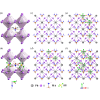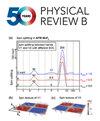Enhanced thermodynamic stability and carrier lifetime in BF4-doped wide-band-gap perovskite solar cells
IF 3.7
2区 物理与天体物理
Q1 Physics and Astronomy
引用次数: 0
Abstract
Recent experiments show that doping a small amount of fluorinated pseudohalides into can enhance the performance of wide-band-gap (WBG) perovskite solar cells. Using time-domain density functional theory and ab initio nonadiabatic molecular dynamics we demonstrate that -doped WBG perovskites not only maintain the high defect tolerance but also exhibit greatly improved thermodynamic stability due to enhanced dissociation energy and reduced thermal atomic fluctuation. The strengthened hydrogen bond network introduces increased lattice rigidity, confined inner space, and the reorientated dipole direction of methylammonium molecules, which synergistically suppress the ion migration in -doped perovskite. Notably, the charge carrier lifetime experiences an order-of-magnitude improvement after doping, which is mainly attributed to the weakened nonadiabatic coupling. This work provides valuable insights into the effect of fluorinated pseudohalides doped in perovskite materials and suggests a promising approach to enhancing the stability and efficiency of WBG perovskite solar cells.

增强掺杂 BF4 的宽带隙过磷酸盐太阳能电池的热力学稳定性和载流子寿命
最近的实验表明,在 CH3NH3PbI3(MAPbI3)中掺入少量含氟拟卤化物(BF4)可以提高宽带隙(WBG)包晶太阳能电池的性能。我们利用时域密度泛函理论和 ab initio 非绝热分子动力学证明,掺杂 BF4 的 WBG 包晶不仅能保持较高的缺陷容限,而且由于解离能的增强和热原子波动的降低,热力学稳定性也得到了极大的改善。氢键网络的加强提高了晶格刚度,限制了内部空间,并改变了甲基铵分子的偶极子方向,从而协同抑制了掺杂 BF4 的 MAPbI3 包晶中的离子迁移。值得注意的是,掺杂 BF4 后,电荷载流子寿命提高了一个数量级,这主要归因于非绝热耦合的减弱。这项研究为了解透辉石材料中掺杂氟化伪卤化物的影响提供了宝贵的见解,并为提高 WBG 透辉石太阳能电池的稳定性和效率提供了一种可行的方法。
本文章由计算机程序翻译,如有差异,请以英文原文为准。
求助全文
约1分钟内获得全文
求助全文
来源期刊

Physical Review B
物理-物理:凝聚态物理
CiteScore
6.70
自引率
32.40%
发文量
0
审稿时长
3.0 months
期刊介绍:
Physical Review B (PRB) is the world’s largest dedicated physics journal, publishing approximately 100 new, high-quality papers each week. The most highly cited journal in condensed matter physics, PRB provides outstanding depth and breadth of coverage, combined with unrivaled context and background for ongoing research by scientists worldwide.
PRB covers the full range of condensed matter, materials physics, and related subfields, including:
-Structure and phase transitions
-Ferroelectrics and multiferroics
-Disordered systems and alloys
-Magnetism
-Superconductivity
-Electronic structure, photonics, and metamaterials
-Semiconductors and mesoscopic systems
-Surfaces, nanoscience, and two-dimensional materials
-Topological states of matter
 求助内容:
求助内容: 应助结果提醒方式:
应助结果提醒方式:


